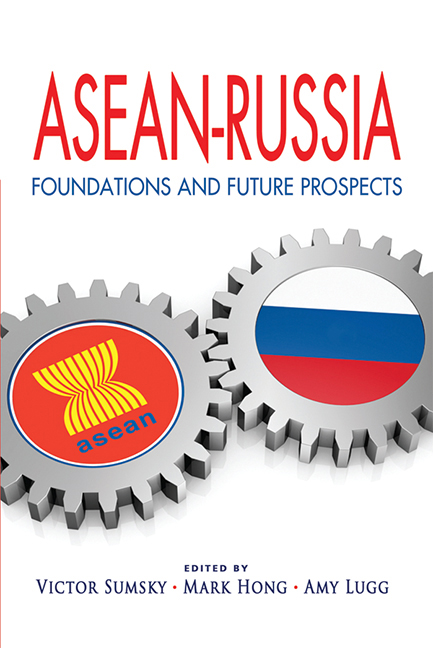Book contents
- Frontmatter
- Contents
- Foreword
- Preface
- About the Contributors
- Keynote Address
- Opening Remarks
- Keynote Address
- Introduction: Russia and the ASEAN Member States: Political and Economic Cooperation in Progress
- SECTION I WISEMEN'S VIEWS
- SECTION II GEOPOLITICS
- SECTION III BILATERAL RELATIONS
- SECTION IV Business and Economics
- SECTION V CULTURE AND EDUCATION
- Credentials of Literature
- A Sentimental Journey through ASEAN (in the Russian Way)
- Food for the Soul and the Stomach
- No Books about Singapore in Russian? Give me a Break! (An Editor's Note)
- National University of Singapore (NUS)-Russia: State of Collaboration
- Soft Power: A Comparison between Britain, France and Russia
- EPILOGUE
- Index
No Books about Singapore in Russian? Give me a Break! (An Editor's Note)
from SECTION V - CULTURE AND EDUCATION
Published online by Cambridge University Press: 21 October 2015
- Frontmatter
- Contents
- Foreword
- Preface
- About the Contributors
- Keynote Address
- Opening Remarks
- Keynote Address
- Introduction: Russia and the ASEAN Member States: Political and Economic Cooperation in Progress
- SECTION I WISEMEN'S VIEWS
- SECTION II GEOPOLITICS
- SECTION III BILATERAL RELATIONS
- SECTION IV Business and Economics
- SECTION V CULTURE AND EDUCATION
- Credentials of Literature
- A Sentimental Journey through ASEAN (in the Russian Way)
- Food for the Soul and the Stomach
- No Books about Singapore in Russian? Give me a Break! (An Editor's Note)
- National University of Singapore (NUS)-Russia: State of Collaboration
- Soft Power: A Comparison between Britain, France and Russia
- EPILOGUE
- Index
Summary
Julia Sherstyuk's determination to bring Singapore and Russia closer together by providing more “food for soul and stomach” is certainly commendable. Personally, I find 103rd Meridian East to be a highly readable general-interest magazine. Julia's Buyan restaurant may be recommended as a cozy refuge to spend an evening tasting designer versions of Russian dishes and drinks.
What I cannot swallow with equal delight is Julia's rather sweeping statement on the lack of books about Singapore in Russian. Any Russian who is curious about Singapore's geography or history, past or present, political trends or economic achievements, will find enough things to read in his (or her) native language — be it academic works or journalistic articles.
Efforts to present Singapore and the neighbouring countries to the Russian reading public are by no means a recent phenomenon. For instance, between 1856 and 1869, Morskoy Sbornik (The Nautical Collection) — a St. Petersburg journal established in 1848 to cover naval matters and published until today — carried no less than ten articles dedicated to the sea currents near the port of Singapore and the specifics of navigation in the Straits of Malacca. Readers can check this information in the section on “Malaya and Singapore” of The Bibliography of Southeast Asia (1960). All in all, this book provides references to 3,752 Russian-language publications about this part of the world that appeared before 1958. Anyone who opens the 1980 sequel to that volume will discover that between 1959 and 1970 there were no less than 67 Russian-language monographs, brochures and articles in academic journals and news magazines about Singapore. As for the total number of Soviet publications on Southeast Asia in that period alone, it was 6,965.
Among those academic writings in Russian that were published about that time and in the two subsequent decades, I would single out such informative pieces of research as Singapore by Gennady Chufrin (1970), Singapore: Problems of a City-State by Nikolai Kalashnikov (1981), The Political System of Contemporary Singapore by Emma Gurevich (1984),
Singapore in the Economy of Southeast Asia by Vitaly Kurzanov (1985), Singapore: A Handbook edited by Gennady Chufrin (1988) and Singapore's Foreign Policy by Gurevich and Chufrin (1989).
- Type
- Chapter
- Information
- ASEAN-RussiaFoundations and Future Prospects, pp. 296 - 301Publisher: ISEAS–Yusof Ishak InstitutePrint publication year: 2012

